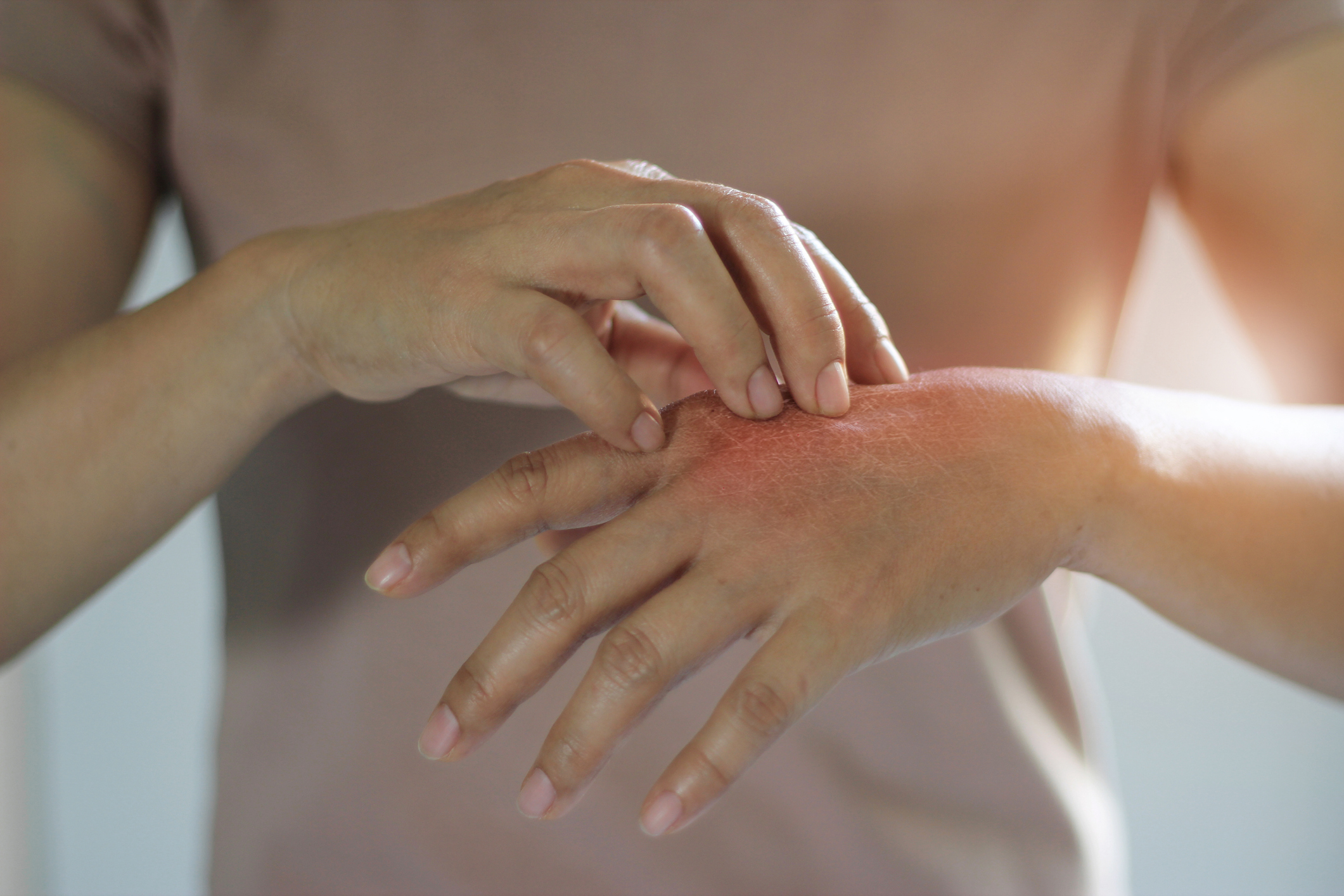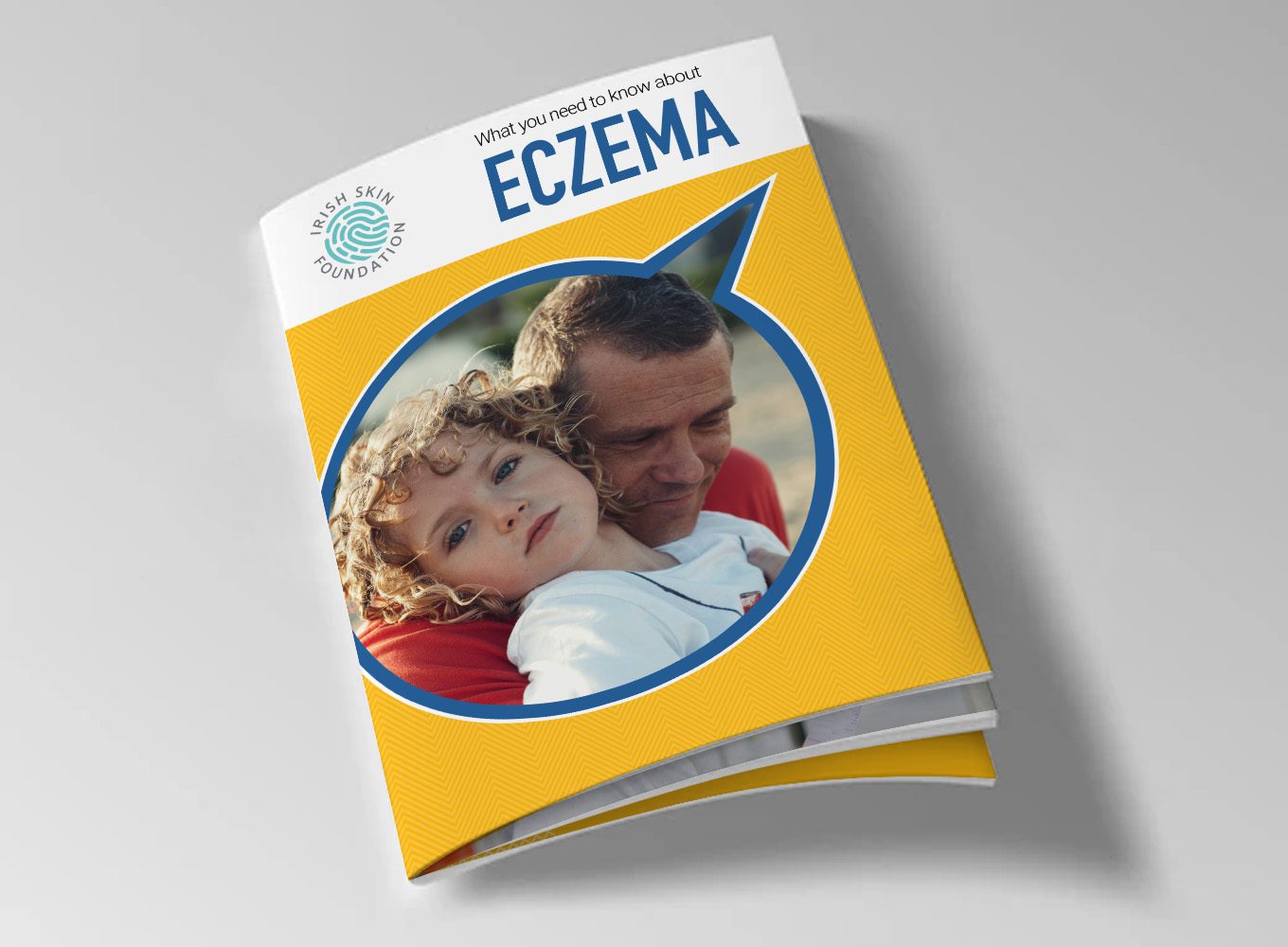Eczema causes a dry, red, itchy rash; it may be scaly, weep, bleed or crust over. Eczema affects 1 in 5 children and 1 in 10 adults.
The words eczema (which comes from the Greek word meaning ‘to boil’) and dermatitis (meaning inflammation of the skin) are often used interchangeably to describe several conditions that cause the skin to become dry, itchy, inflamed or irritated.
There are a number of different types of eczema but the term is most often used to refer to atopic eczema (also called atopic dermatitis).
The word atopic refers to hypersensitivity reactions to something in the environment.
Atopic eczema is a very common, non-contagious, chronic (long-term) inflammatory skin condition. If you have atopic eczema, your skin barrier function (which prevents water loss and protects against allergens and irritants) is impaired or weakened. This makes the skin dry out and become more vulnerable to infections by bacteria and viruses.

Our What you need to know about Eczema booklet has been prepared by people with eczema, parents, carers, dermatology nurses and consultant dermatologists to help you understand your condition, learn about management and find useful tips for living with eczema.

While the exact cause is not known, certain factors are thought to be important in its development, these include an inherited (genetic) predisposition to have a weakened skin barrier, as well as altered inflammatory and allergy responses. Atopic eczema most frequently begins in infancy but may also develop for the first time in adulthood. It affects approximately 1 in 5 children and 1 in 10 adults in Ireland.
For most children affected, the disease is mild. However, often those who have seemingly outgrown the condition will continue to have life-long sensitive skin and may have recurrences of eczema following long symptom-free spells.
Atopic eczema can run in families and frequently occurs alongside other atopic conditions, including hay fever and asthma.
Although there is no cure for eczema yet, treatment are available to manage the condition.
Symptoms include red, dry, itchy skin, which can sometimes weep, become blistered, crusted and thickened. However, the appearance of eczema and the locations of the body affected can vary greatly depending on the age of the person affected.
The main symptom is an intense itch. Scratching only provides temporary relief, and leads to more itching and scratching (the itch-scratch cycle), which can worsen eczema and make the skin more vulnerable to infection. Scratching in response to itch can cause some of the changes seen on the skin in eczema.
The intense itch is very uncomfortable, can be severe enough to interfere with sleep, and negatively impact on the quality of life of the person affected, as well as his/her family. Some people with more pronounced eczema can also experience social embarrassment due to the visibility of their condition.
Typically atopic eczema goes through phases of being severe, then less severe. During a ‘flare up’, when eczema is very active, symptoms such as redness, dryness and itch worsen, while at other times, symptoms settle.
Irritants and allergens
Atopic eczema can be triggered or aggravated by exposure to a number of environmental irritants or allergens. Common irritants include soap, bubble bath, shampoo, laundry detergents, fragrances, clothing that feels ‘itchy’ next to the skin (e.g. wool), changes in temperature, or allergens like animal dander, the house dust mite or pollen, but sometimes no cause can be identified.
Stress
Emotional stress can aggravate eczema. Finding ways to reduce stress may lessen the frequency and, hopefully, the intensity of the flare-ups. Whilst stress is associated with flares of atopic eczema, it is not yet fully understood.
Infection
Atopic skin is more vulnerable to infection and infection is often associated with a worsening of eczema.
Seek urgent medical advice if skin becomes:
• Wet or weepy, with yellow/brownish crusts
• Very sore, with clusters of painful itchy blisters, particularly if there has been contact with someone who has a cold sore
The main aim is to improve symptoms and achieve long-term control. In atopic eczema, the skin’s protective barrier is weakened which allows moisture to be lost, and irritants and allergens to pass through the skin more easily. Some common everyday substances e.g. soap, contribute to the weakening of the skin’s barrier and should be avoided.
It is important to remember that on-going (every day), frequent and generous use of emollients form the basis of eczema management, but when your eczema flares up, other treatments, such as topical steroids, are needed and are usually prescribed by your healthcare professional.
For more detailed information about prescribed medical treatments including: topical steroids and other topical treatments (creams or ointments applied directly to the skin), ultraviolet light therapy (also called phototherapy, delivered in hospital dermatology departments), and systemic medications (medicines that work inside your body), please see our What you need to know about eczema booklet above.
For eczema, the good news is that there is a range of treatment options available, as well as on-going research examining potential new treatments. Treatment depends on the severity and location of eczema, as well as the age of the person affected.
Talk with your doctor to find a treatment regimen that is most appropriate for you.
Emollients
Emollients are an essential part of daily care, even when skin is clear. Emollients are moisturizers that are used in two ways – applied directly to the skin as a leave-on moisturizer, and as a soap substitute instead of soap or shower gel.
Used several times a day, emollients help to soothe dry, itchy skin and repair the skin’s barrier, thereby preventing entry of irritants and allergens, which can trigger eczema flares.
Soap substitutes/emollient wash products
Ordinary soaps, bubble baths and shower gels should be avoided as they dry out the skin by stripping away its natural oils. Instead, choose emollient wash products when bathing which leave the skin coated with a protective film afterwards.
Choosing an emollient
Emollients come as lotions, creams and ointments. Finding the right emollient is often a matter of trial and error but the best emollients are ones that you (or your child) prefer to use and will continue to use every day.
Remember, a higher price doesn’t necessarily indicate a better product – ask your healthcare professional for advice.
Some practical tips for emollient therapy
It is very important to establish the right diagnosis, so if you are concerned about your skin, you should always speak with your doctor.
Sometimes it can be difficult for children or indeed anyone who suffers with eczema to find comfortable clothing, particularly when there has been a flare up of the condition. Clothing can aggravate eczema as skin can be very hot and heat increases itch.
Basic tips:
Bedtime
Itchy Little Monkeys*
Offer a practical solution in the form of the Shruggi™ which protects your child’s skin from the damage of scratching. Made from 100% organic cotton and silk, with the Shruggi™ you can say goodbye to traditional scratch mittens. They also offer a refreshing change for bed-time routines through story books. Introduce your kids to the characters of Max & Mimi, they have itchy skin too so they know what your little ones are going through. Their stories are created with both child & parent in mind – fun for kids & educational for you!
To find out more about them and their products:
Visit: www.itchylittlemonkeys.com
Contact: info@itchylittlemonkeys.com
Clinifast Garments
Made in the UK but Irish agents are Ovelle in Dundalk. Ovelle stock Clinifast garments in adult and children’s sizes, all of which are available to order on their website: Clinifast Range
Free shipping within Ireland on orders over €25.
Clinifast garments are a convenient quick and simple way to wet or dry wrap in the treatment of paediatric atopic eczema.
Due to its readymade design, there is no need to cut, tie or pin bandages together, making it easier for parents and carers to apply.
Clinifast garments are made from breathable ‘staysoft’ fabric with two way stretch design. They are comfortable to wear both at night and during the day and they allow complete freedom of movement to encourage a full and active life.
Skinnies
Skinnies have developed a range of Therapeutic Clothing Products that help aid recovery from Eczema & other skin conditions. Garments are completely seamless, utilising technologically advanced yarns that are designed to be anti-irritant.
Skinnies are high quality, robust garments for every day and wear and tear, with a combination of colour, style and comfort, which belies a serious medical purpose.
For further information about the Skinnies range and order information, please go to the website:
Dermasilk
DermaSilk® – a unique range of Therapeutic Clothing. DermaSilk® Therapeutic Clothing is used in the treatment of various forms of dermatitis, eczema and allergic skin conditions that affect different areas of the body across all age groups.
DermaSilk Therapeutic Clothing is made of a special, knitted medical grade silk which has been stripped of its outer coating and bonded with Microbe Shield technology. It is far superior to cotton because it retains up to 30% of its own weight in moisture without feeling damp.
DermaSilk® products are available through Irish supplier, Medearly Healthcare.
Other sites:
The Irish Skin Foundation does not endorse any particular products, any statement on this page should not be construed as a testimonial. Contact us for further details or guidance about clothing.

Does food allergy cause eczema? No! Eczema is a genetic skin problem caused by a defect in the skin barrier. It is not an allergy. Is there an association between food allergy and eczema? Yes!
Find out more below from the answers to 20 common questions about food allergy (download to print version) and also from our Information Booklets and Resources webpage:
1: What is food allergy?
Food Allergy can be divided into two types; immediate and delayed. Symptoms of immediate food allergy usually begin very quickly after eating the food, nearly always within less than 15 minutes but very rarely up to as long as 2 hours.
Symptoms include hives (nettle sting type rash), swelling, sudden sneezing and nasal blockage, eye symptoms such as itch, redness and watering. There may also be abdominal symptoms such as pain and vomiting but these are rare without other symptoms. In some instances more severe symptoms such as breathing difficulties or collapse can develop. This is known as anaphylaxis.
Infants can also develop delayed allergy to cow’s milk, cow’s-milk-based baby formula and other forms of dairy (e.g. milk, cheese, yogurt). These symptoms can occur between 2 and 24 hours after ingestion (eating/drinking). They include a combination of tummy symptoms such as vomiting, diarrhoea, blood in the stools (poo), tummy bloating, reflux.
These infants are not at risk of anaphylaxis because the mechanisms of these types of reaction are quite different. Dairy (and other foods, but this is even more rare) can occasionally also make eczema worse, but this is not as common as is widely thought.
2: Is food allergy common in Ireland?
Yes, food allergy is increasingly common across the western world. 4% of infants in Ireland have immediate-type food allergy. Delayed reactions may be a bit more common.
3: What are the most common food allergies?
In Ireland, egg is the most common food allergy followed by milk allergy and peanut allergy. Tree nut allergy (cashew, pistachio, hazelnut etc.) sesame seed allergy and kiwi allergy are also common but probably 10 times less common than the “big 3” of egg, milk and peanut. Immediate allergy to wheat and soya are actually very unusual.
4: How do I know if my child has food allergy?
The only true way of knowing if your child has a food allergy is by feeding them that food. You can be certain that your child does not have immediate food allergy to a food if they can eat it without immediately developing nettle sting type rash and swelling.
If you think that your infant is developing sudden rashes after eating a food then it is best to discuss with your doctor before feeding it to them again.
5: What is the difference between allergy tests and intolerance tests?
Allergy tests are used to help predict whether a person will have an immediate allergic reaction to a food. There are only two forms of allergy testing that should be performed; 1. Skin prick 2. Blood test for specific IgE (this used to be known as a “RAST” test).
Intolerance tests are widely advertised as being able to help identify underlying food causes of symptoms such as abdominal pain and bloating, migraine, arthritis etc. and also eczema, however there is no scientific basis to these claims.
6: How good are allergy tests at diagnosing allergy?
Surprisingly, allergy tests are actually not very helpful. If your child has a positive allergy test to a food it does not mean that they are definitely allergic to that food. It only tells us that they are “sensitised” to that food. This means that at some time their immune system considered developing an allergy to that food.
If they are now eating that food then this is great news and they should continue to eat it. If they have not started eating the food you should talk to your doctor before introducing it as it might need to be done under medical supervision. This is known as a “food challenge”.
Allergy tests are of no value in children with delayed milk allergy.
7: “My 7 month old infant developed hives on her face after eating scrambled egg. Should I avoid all foods containing egg?”
No! Most infants (>85%) with doctor proven egg allergy can tolerate egg in baked foods such as cake, scones, pancake and egg pasta. If your infant is already tolerating any of these then they should be kept in their diet because this will help them grow out of the allergy.
If not already eating them, then you should start by giving your child small amounts of egg that’s been baked in cake or muffin.
8: “My 8 month old infant had an anaphylactic reaction to egg in a pancake. Should I try and introduce baked egg into their diet?”
No, best not to! Any infant who has had a reaction to egg that has caused them to have difficulty breathing or caused them to collapse should not have any egg introduced into their diet until they have first been seen by a doctor with expertise in food allergy.
9: “My son has a peanut allergy. Will allergy testing tell me how bad his reactions will be?”
No! Allergy testing does not predict how severe a food allergy reaction will be. Doctors with experience in allergy know that listening to the story of your child’s reactions is more helpful but even then there is no definite way of predicting exactly what type of reaction your child will experience. It is often said that reactions get worse with each successive one. This is actually not true.
Children who have had an anaphylactic reaction in the past can go on to have subsequent milder reactions. Good control of any asthma symptoms is important in reducing the risk of a severe allergic reaction.
10: Is peanut allergy the most dangerous allergy?
This is a tough question, and is debated widely. It is a fact that peanut causes more cases of anaphylaxis than any other food but the reasons are complex. It Is better to be aware that any food allergy can potentially trigger a life threatening allergic reaction.
11: Does food allergy cause eczema?
No! Eczema is a genetic skin problem caused by a defect in the skin barrier. It is not an allergy. There is no magic bullet to cure eczema. Food should not be removed from infant’s diets to try and fix their eczema. Removing a food to fix eczema is rarely successful, and affects your child’s nutrition.
12: “I breast feed my baby. I heard that I should take cow’s milk out of my diet to treat my infant’s eczema. Is this correct?”
No! Eczema is a genetic skin problem caused by a defect in the skin barrier. It is not an allergy.
Eczema is best treated with bathing, emollients and topical steroids.
However:
13: Is there an association between food allergy and eczema?
Yes! Infants and children with eczema, particularly those with eczema that appeared very early in life (less than 6 months of age) and also severe eczema are more likely to develop immediate food allergy than those with normal skin.
14: “My child has eczema. Should I have them allergy tested?”
There may be some role for allergy testing, however, under no circumstances should your child have extensive allergy testing to all the foods already in their diet that they are able to eat.
These large “allergy screening panels” are often offered in the private sector but are completely pointless. No foods should ever be removed from a child’s diet merely because of a positive food allergy test.
Allergy doctors mostly use allergy tests as a guide to getting important foods back into children’s diets, rather than taking them out. If your child has eczema and is not already eating nuts then allergy testing may be helpful before they are introduced into their diet.
15: “My 1 year olds face becomes red and itchy after eating tomato but their allergy test was negative. What does this mean?”
This is a very common finding. Foods such as tomato, citrus and berry fruits, act as irritants when they contact with the face of infants, especially those with eczema around their face. This will settle as their skin condition improves.
16: “My first child has eczema and food allergy. Is there anything I can do prevent my next child developing food allergy?”
Recent studies have shown that delaying introduction of allergic foods into infant’s diets increases their risk of developing food allergy, especially if they have eczema. Infants actually have to eat foods in order to become tolerant to them.
Introducing peanut regularly (3 times a week) into infants diets as soon as they begin to wean will significantly reduce their risk of developing peanut allergy. Infants with severe eczema should have an allergy test before giving them peanut.
This test can be performed as early as 5-6 months of age. Current international advice also says other allergenic foods (e.g. egg, fish, sesame, shrimp, tree nuts – in safe spreadable forms, not as nuts or nut fragments) should be introduced without delay.
This is a revolution of medical advice and may be why you are even reading this fact sheet!
17: Do food allergies ever go away?
Yes! It is the norm (>80% by 5 years) for milk and egg allergy to get better and this is helped by early introduction of baked egg and baked milk (see questions 7 and 8). However peanut, tree nut and fish allergies rarely go away (only 20% of cases).
Allergy review and testing over a few years can help identify the small number of children who may recover from their nut allergy. They may need to have a medically supervised food challenge to prove they have become tolerant.
18: Do all children with food allergy need to carry adrenaline pens?
No! Most egg and milk allergic children do not need such kits. In contrast, most peanut and tree nut allergic children do need them, eventually, especially when of school age, and maybe not until then. This is another area of medical debate that will keep evolving.
19: “My child has peanut allergy. I am worried about taking him on a plane”.
Plane journeys are generally very safe for food allergic people. It is important to follow a few simple rules.
20: Are there any cures coming for food allergy?
Yes! Studies have been carried out looking at how best to gradually introduce allergic foods in order to “desensitise” the immune system. This is called Immunotherapy. Foods such as egg, milk and nuts have been studied. Many other studies are still in progress.
An immunotherapy peanut tablet called Palforzia has recently been licensed in USA. This is not yet licensed in Europe.
Other forms of immunotherapy still being studied include skin patches and nasal sprays.
It is dangerous to consider doing this yourself and be aware that deaths have occurred in settings where alternative practitioners have done this.
The UK’s National Eczema Society has developed a new school pack to help teachers and parents with back-to-school season.
New schools packs from the National Eczema Society are now online! You can have a look and/or download it here.
The ISF gratefully acknowledges the National Eczema Society for their work on these resources.
Some general tips
For more tips on managing your eczema, please see our What you need to know about eczema booklet above.
You may find “Childhood Eczema: Recent Advances and Patient Perspectives”, presented by Prof. Alan Irvine, useful and helpful in learning more about eczema.
Videos about atopic eczema recorded at the Irish Skin Foundation’s (ISF) skin health event, SkinSideOut on 22 April 2023 are available to view below.
Atopic eczema talk
Talk on atopic eczema, presented by Prof Alan Irvine, Consultant Dermatologist, St James’s Hospital, Dublin, Ireland.
Atopic eczema panel discussion
Atopic eczema panel discussion with Prof Alan Irvine Consultant Dermatologist, St James’s Hospital; Paul Herriott, Eczema Patient Advocate; and Glenn Kenneally, Eczema Patient Advocate.
Do you have questions about your skin? Ask a dermatology clinical nurse specialist by filling in the Ask-a-Nurse form. Learn more about how the ISF Helpline here and about our Terms of Use.







Irish Skin Foundation, Charles Institute of Dermatology, University College Dublin, Dublin D04 V1W8, Ireland.
tel: (01) 486 6280 | e-mail: info@irishskin.ie | www.irishskin.ie
Registered Charity Number: 20078706